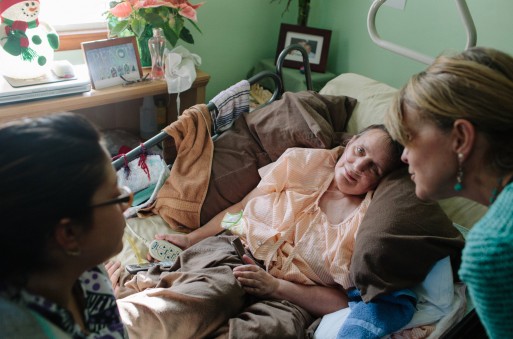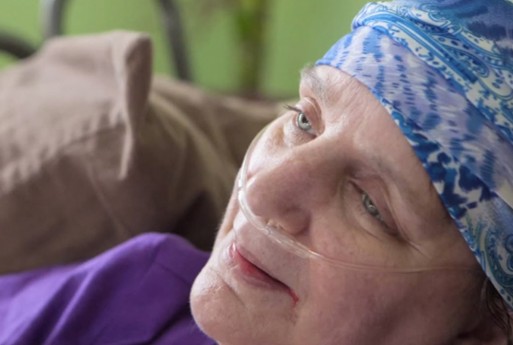
Martha Keochareon with Cindy Santiago (left) and Michelle Elliot (right)
(credit: www.nytimes.com)
Sometimes people donate their bodies to science after death, but Martha Keochareon had offered herself as an instructional tool during her last two months of life. In November of 2013, Ms. Keochareon called Kelly Keane, a counselor at Holyoke Community College in Holyoke, MA, with a proposal. She wanted to give the students an opportunity to care for a hospice patient dying of cancer. A nurse and a Holyoke Community College alumna herself, Martha knew she would be the perfect subject: someone who was experiencing a real condition and had the ability to explain it in human and medical terms. Most of all, Ms. Keochareon saw a need for teaching medical professionals how to prepare their patients and their families for death.
We live in a death-denying society, and that includes nursing.
— Pam Malloy
There are simply not enough settings where nursing students can spend time with dying patients. “We live in a death-denying society, and that includes nursing,” said Pam Malloy, the project director for The End-of-Life Nursing Education Consortium. While being interviewed by Abby Goodnough for a story about Keochareon in the New York Times, Malloy revealed that in the nursing profession, “people have begun to understand it’s important, but we’re nowhere where we need to be at this point.” Aside from their time on the medical-surgical floor of a hospital, nursing students mostly learn from textbooks and train on lifelike mannequins at the lab.

Credit: www.abibitumikasa.com
Ms. Keochareon gave students a rare opportunity to find out what a tumor feels like and what to do to make a dying patient more comfortable. She reassured that they could ask her anything about what she was going through. “Sit on my bed and talk to me,” Martha asked the first-year students, Cindy Santiago, 26, and Michelle Elliot, 52, during their initial visit to Martha’s little house a few miles away from the college. Immediately the two students were uncertain. They were taught how to take a patient’s vitals, give medicine and instructed not to sit on patients’ beds for the fear of spreading germs. They did not, however, know how to truly support someone through the process of dying. This was completely different from what they’ve experienced at the hospital or at the lab.
“To dig a little deeper” was Martha’s advice for her students. While most die of pancreatic cancer within months after the diagnosis, Martha had lived with cancer for years before it was correctly identified. Contrary to the students’ expectations, Martha’s reaction to her diagnosis was relief. After years of suffering and even being told that her excruciating pain was psychosomatic, she finally knew what was wrong. Even when the pain became so unbearable that it took Ms. Keochareon’s medical team days to find the right combination of drugs of to make her comfortable, Martha insisted that her students keep visiting. They were also privy to the mental and physical exhaustion that Martha’s family was experiencing while caring for a much-loved relative. Kelly Keane summed up the process, “the patient isn’t Martha per se, it’s the entire family.” At that time, Ms. Keane asked the students to practice “therapeutic communication,” and just let the patient talk instead of asking questions.
The patient isn’t Martha per se, it’s the entire family.
— Kelly Keane
During Martha’s last days, Michelle Elliot and Cindy Santiago comforted their patient when nothing else helped her pain and confronted their own fears of death. Ms. Elliot marveled at the tranquility with which their patient seemed to face death. “You want to ask them the questions: So what does it feel like to be dying? Do you know something we don’t know?” On December 29, 2013, Martha Keochareon died peacefully at home.
While still working in her field, Ms. Keochareon loved teaching new nurses. During the last stages of cancer, she had offered herself as a subject of study to provide invaluable learning experience to students. Her intent was twofold. “I notice that every time that Martha gave of herself she received far more,” said Martha Keochareon’s sister, Ruth Woodard at Martha’s eulogy, “In fact, she received a few moments of less pain and I suspect that she received life itself — a few more hours, even days, with purpose.”

 A Few More Days of Purpose
A Few More Days of Purpose


 “Help Me, Helen”
“Help Me, Helen”

 “As Tears Go By” by Marianne Faithfull
“As Tears Go By” by Marianne Faithfull














